Simplified Model Study of Autoclaved Aerated Concrete Masonry Flexible Connection Infilled Frames with Basalt Fiber Grating Strips
Abstract
1. Introduction
2. Experiment Overview
3. Simplified Model Establishment and Boundary Condition Settings
3.1. Frame and Infilled Wall Simplification
3.2. Frame and Infilled Wall Simplification
3.3. Boundary Condition and Loading Condition Settings
4. Material Constitutive Relationship
4.1. Reinforcement Constitutive Relationship
4.2. Concrete Constitutive Relationship
4.3. Autoclaved Aerated Concrete Masonry Constitutive Relationship
4.4. Airbag Model Constitutive Relationship
5. Comparison and Analysis of Calculation Results
5.1. In-Plane Calculation Results
5.2. Out-of-Plane Calculation Results
- Pseudo-linear stage (Stage I): before the wall cracks, the out-of-plane force–displacement relationship is approximately linear.
- Strengthening stage (Stage II): the wall enters a plastic state, and its out-of-plane stiffness gradually decreases.
- Yielding stage (Stage III): the out-of-plane load-carrying capacity of the wall gradually reaches its peak, accompanied by significant out-of-plane deformation.
- Degradation stage (Stage IV): The out-of-plane load-carrying capacity of the wall starts to degrade and decreases to below 85% of the ultimate load-bearing capacity.
6. Discussion
7. Conclusions
- The simplified model, utilizing beam elements to simulate frame components, shell elements to simulate infill walls, and spring elements to simulate connectors, can effectively and reliably simulate specimens of BFG strip-reinforced AAC masonry flexible connection infilled walls. By defining the force–displacement relationship of the spring elements, it is possible to simulate different types of connectors.
- The simulation of in-plane loading indicates that the hysteresis curve and skeleton curve of ISM exhibit similarity to NF-1, exhibiting similar initial stiffness, peak bearing capacity, stiffness degradation behavior, and strength attenuation behavior. By adjusting the size parameters, material parameters, and force–displacement relationship of the springs in the model, it is possible to achieve in-plane loading simulation of flexible connection infilled walls with different materials.
- The simulation of out-of-plane loading indicates that the OSM curve in the pseudo-linear, strengthening, and yielding stages exhibits similarities to NF-2. At the crack and peak points, the arching effect of the OSM is similar to that of NF-2, exhibiting a significant plastic range. The maximum plastic range of the two is only 5% different. Due to the poor simulation performance after the peak point, it is recommended to use the OSM for out-of-plane loading simulation of flexible connection infilled walls, focusing solely on the force–displacement relationship before the peak point. Similarly, by adjusting the size parameters, material parameters, and force–displacement relationship of the springs in the model, it is possible to achieve out-of-plane loading simulation of flexible connection infilled walls with different materials.
Author Contributions
Funding
Data Availability Statement
Conflicts of Interest
References
- Liu, X.; Jiang, H. State-of-the-art of performance-based seismic research on nonstructural components. Earthq. Eng. Eng. Vib. 2013, 33, 53–62. (In Chinese) [Google Scholar]
- He, S.; Qu, Z.; Zhou, H.; Dai, J.; Wang, D. State of the art of testing methods for nonstructural components in seismic areas. China Civ. Eng. J. 2017, 50, 16–27. (In Chinese) [Google Scholar]
- Dias-Oliveira, J.; Rodrigues, H.; Asteris, P.G.; Varum, H. On the Seismic Behavior of Masonry Infilled Frame Structures. Buildings 2022, 12, 1146. [Google Scholar] [CrossRef]
- Charleson, A. Seismic Design for Architects; Routledge: London, UK, 2008. [Google Scholar]
- Tabeshpour, M.R.; Azad, A.; Golafshani, A.A. Seismic behavior and retrofit of infilled frames. In Earthquake-Resistant Structures—Design, Assessment and Rehabilitation; IntechOpen: London, UK, 2012; pp. 280–306. [Google Scholar]
- Abdel-Hafez, L.M.; Abouelezz, A.E.Y.; Elzefeary, F.F. Behavior of masonry strengthened infilled reinforced concrete frames under in-plane load. HBRC J. 2015, 11, 213–223. [Google Scholar] [CrossRef]
- Perrone, D.; Leone, M.; Aiello, M.A. Evaluation of the infill influence on the elastic period of existing RC frames. Eng. Struct. 2016, 123, 419–433. [Google Scholar] [CrossRef]
- Paulay, T.; Priestley, M.J.N. Seismic Design of Reinforced Concrete and Masonry Buildings; Wiley: New York, NY, USA, 1992. [Google Scholar]
- Sattar, S.; Liel, A.B. Seismic performance of reinforced concrete frame structures with and without masonry infilled walls. In Proceedings of the 9th U.S. National and 10th Canadian Conference on Earthquake Engineering, Toronto, ON, Canada, 25–29 July 2010. [Google Scholar]
- Mosalam, K.M.; Günay, S. Progressive collapse analysis of reinforced concrete frames with unreinforced masonry infilled walls considering in-plane/out-of-plane interaction. Earthq. Spectra 2015, 31, 921–943. [Google Scholar] [CrossRef]
- Papatheodorou, K.; Theodoulidis, N.; Klimis, N.; Zulfikar, C.; Vintila, D.; Cardanet, V.; Kirtas, E.; Toma-Danila, D.; Margaris, B.; Fahjan, Y.; et al. Rapid Earthquake Damage Assessment and Education to Improve Earthquake Response Efficiency and Community Resilience. Sustainability 2023, 15, 16603. [Google Scholar] [CrossRef]
- Takagi, J.; Wada, A. Recent earthquakes and the need for a new philosophy for earthquake-resistant design. Soil Dyn. Earthq. Eng. 2019, 119, 499–507. [Google Scholar] [CrossRef]
- Mohammadi, M.; Akrami, V. An engineered infilled frame: Behavior and calibration. J. Constr. Steel Res. 2010, 66, 842–849. [Google Scholar] [CrossRef]
- Morandi, P.; Milanesi, R.R.; Magenes, G. Innovative seismic solution for clay masonry infills with sliding joints: Principles and details. In Proceedings of the 16th International Brick and Block Masonry Conference, Padova, Italy, 26–30 June 2016. [Google Scholar]
- Preti, M.; Bettini, N.; Plizzari, G. Infilled walls with sliding joints to limit infill-frame seismic interaction: Large-scale experimental test. J. Earthq. Eng. 2012, 16, 125–141. [Google Scholar] [CrossRef]
- Ju, R.S.; Lee, H.J.; Chen, C.C.; Tao, C.C. Experimental study on separating reinforced concrete infilled walls from steel moment frames. J. Constr. Steel Res. 2012, 71, 119–128. [Google Scholar] [CrossRef]
- Ahmadi, H.; Dusi, A.; Gough, J. A rubber-based system for damage reduction in infill masonry walls. In Proceedings of the 16th World Conference on Earthquake Engineering, Santiago, Chile, 9–13 January 2017. [Google Scholar]
- Tsantilis, A.V.; Triantafillou, T.C. Innovative seismic isolation of masonry infills using cellular materials at the interface with the surrounding RC frames. Eng. Struct. 2018, 155, 279–297. [Google Scholar] [CrossRef]
- Kumar, S.M.; Satyanarayanan, K.S. Study the effect of elastic materials as interface medium used in infilled frames. Mater. Today Proc. 2018, 5, 8986–8995. [Google Scholar]
- Marinković, M.; Butenweg, C. Innovative system for earthquake resistant masonry infilled walls. In Proceedings of the 16th European Conference on Earthquake Engineering, Thessaloniki, Greece, 18–21 June 2018. [Google Scholar]
- Ghamari, A.; Khaloo, A. An innovative infilled wall utilizing light expanded clay aggregate: An experimental and numerical study. Struct. Des. Tall Spec. Build. 2020, 29, e1791. [Google Scholar] [CrossRef]
- Umar, Z.; Shah, S.A.A.; Bibi, T.; Shahzada, K.; Ahmad, A. Innovative seismic isolation of masonry infills using cellular material at the interface with the surrounding RC frame. J. Build. Eng. 2021, 40, 102736. [Google Scholar] [CrossRef]
- Wang, Z.; Xiong, L.; Chen, G.; Luo, M.; Zhang, S. Out-of-plane performance of infilled frames with the improved flexible connection. J. Build. Eng. 2022, 51, 104286. [Google Scholar] [CrossRef]
- ASCE/SEI 41-13; Seismic Evaluation and Retrofit of Existing Buildings. American Society of Civil Engineers: Reston, VA, USA, 2014.
- NZS 4320; New Zealand Standard, Design of Reinforced Concrete Masonry Structures. Standards New Zealand: Wellington, New Zealand, 2014.
- GB 50011-2010; Code for Seismic Design of Buildings. Ministry of Housing and Urban-Rural Development of the People’s Republic of China: Beijing, China, 2016. (In Chinese)
- JGJ339-2015; Code for Seismic Design of Non-Structural Components. Ministry of Housing and Urban-Rural Development of the People’s Republic of China: Beijing, China, 2015. (In Chinese)
- Aliaari, M.; Memari, A.M. Analysis of masonry infilled steel frames with seismic isolator subframes. Eng. Struct. 2005, 27, 487–500. [Google Scholar] [CrossRef]
- Kauffman, A.; Memari, A.M. Performance Evaluation of Different Masonry Infilled walls with Structural Fuse Elements Based on In-Plane Cyclic Load Testing. Buildings 2014, 4, 605–634. [Google Scholar] [CrossRef]
- Tasligedik, A.S.; Pampanin, S.; Palermo, A. Low damage seismic solutions for non-structural drywall partitions. Bull. Earthq. Eng. 2015, 13, 1029–1050. [Google Scholar] [CrossRef]
- Tasligedik, A.S.; Pampanin, S. Rocking cantilever clay brick infilled wall panels: A novel low damage infilled wall system. J. Earthq. Eng. 2017, 21, 1023–1049. [Google Scholar] [CrossRef]
- Saad, A.S.; Ahmed, T.A.; Radwan, A.I. In-Plane Lateral Performance of AAC Block Walls Reinforced with CFPR Sheets. Buildings 2022, 12, 1680. [Google Scholar] [CrossRef]
- Erdem, M.M.; Emsen, E.; Bikçe, M. Experimental and numerical investigation of new flexible connection elements between infilled walls-RC frames. Constr. Build. Mater. 2021, 296, 123605. [Google Scholar] [CrossRef]
- Zhou, X.; Cheng, C.; Du, J.; Chen, K.; Chen, P. Seismic performance test of frame structure infilled with steaming gassed concrete masonry. World Earthq. Eng. 2022, 38, 46–57. (In Chinese) [Google Scholar]
- CECS 289-2011; Technical Code for Masonry Structure of Autoclaved Aerated Concrete Block. China Association for Engineering Construction Standardization: Beijing, China, 2011. (In Chinese)
- Xiong, L.; Chen, G.; Lin, D.; Luo, M.; Yang, C. Test on basic mechanical properties of autoclaved aerated concrete block masonry with basalt fiber grille. Build. Sci. 2017, 33, 48–54. (In Chinese) [Google Scholar]
- Chen, G. Experimental Study on Seismic Performance of BFG Autoclaved Aerated Concrete Block Infilled Wall Frame. Master’s Thesis, China Earthquake Administration Institute of Engineering Mechanics, Harbin, China, 2017. [Google Scholar]
- Luo, M. Study on Out-of-plane Seismic Behavior of BFG Reinforced Masonry Infilled Wall with Flexible Connections. Master’s Thesis, China Earthquake Administration Institute of Engineering Mechanics, Harbin, China, 2018. [Google Scholar]
- Liu, J. ABAQUS-based Research on Seismic Performance of Reinforced Masonry Infilled wall with Flexible Connections. Master’s Thesis, China Earthquake Administration Institute of Engineering Mechanics, Harbin, China, 2019. [Google Scholar]
- Chen, D. Numerical Simulation for Seismic Performance of Flexible Connection Masonry-Infilled RC Frames. Master’s Thesis, China Earthquake Administration Institute of Engineering Mechanics, Harbin, China, 2020. [Google Scholar]
- Wang, Z. Seismic Performance and Fragility Analysis of Infilled Frames with the Improved Flexible Connection. Master’s Thesis, China Earthquake Administration Institute of Engineering Mechanics, Harbin, China, 2022. [Google Scholar]
- Forcellini, D. An expeditious framework for assessing the seismic resilience (SR) of structural configurations. Structures 2023, 53, 105015. [Google Scholar] [CrossRef]
- Kourehpaz, P.; Molina, H.C. Machine learning for enhanced regional seismic risk assessments. J. Struct. Eng. 2022, 148, 4022126. [Google Scholar] [CrossRef]
- Rasool, A.M.; Afzal, M.F.U.D.; Rashid, M.U. Enhancing Seismic Resilience: Evaluating Buildings with Passive Energy Dissipation Strategies. Eng 2024, 5, 367–383. [Google Scholar] [CrossRef]
- Jiang, S.; Chen, Q.; Li, C.; Song, H.; Lin, E.; Fu, C. Assessment of Soft-First-Floor Structures Reinforced by Rocking Frame Based on Seismic Resilience. Buildings 2024, 14, 197. [Google Scholar] [CrossRef]
- Cui, H.; Tao, R.; Bao, X.; Wu, X.; Qiu, T.; Shen, J.; Han, Z.; Chen, X. Seismic Resilience Evolution of Shield Tunnel with Structure Degradation. Appl. Sci. 2024, 14, 72. [Google Scholar] [CrossRef]
- Li, P.; Li, X.; Wang, X.; Wang, D. Seismic Resilience Evaluation of Reinforced Concrete Frame Considering the Effect of Mainshock-Aftershock Sequences. Appl. Sci. 2023, 13, 12620. [Google Scholar] [CrossRef]
- Prasanth, S.; Ghosh, G.; Gupta, P.K.; Casapulla, C.; Giresini, L. Accounting for Resilience in the Selection of R Factors for a RC Unsymmetrical Building. Appl. Sci. 2023, 13, 1316. [Google Scholar] [CrossRef]
- Joyner, M.D.; Sasani, M. Building performance for earthquake resilience. Eng. Struct. 2020, 210, 110371. [Google Scholar] [CrossRef]
- FEMA-P58; Seismic Performance Assessment of Buildings. Federal Emergency Management Agency: Washington, DC, USA, 2012.
- GB 38591-2020; Standard for Seismic Resilience Assessment of Buildings. State Administration for Market Regulation, Standardization Administration of the People’s Republic of China: Beijing, China, 2020. (In Chinese)
- Almufti, I.; Willford, M. REDi™ Rating System: Resilience-Based Earthquake Design Initiative for the Next Generation of Buildings; Arup Co.: London, UK, 2013. [Google Scholar]
- Mayes, R.L.; Reis, E. The US Resiliency Council (USRC) and the building rating system. In Proceedings of the SEI Conference on Improving the Seismic Performance of Existing Buildings and Other Structures, San Francisco, CA, USA, 10–12 December 2015. [Google Scholar]
- El Haddad, M.H. Finite element analysis of infilled frames considering cracking and separation phenomena. Comput. Struct. 1991, 41, 439–447. [Google Scholar] [CrossRef]
- Liu, L.; Tang, X. The non-linear finite element analysis of reinforced concrete frame structures with slit masonry filler wall. J. Suzhou Univ. Sci. Technol. (Eng. Technol.) 2010, 23, 49–53. (In Chinese) [Google Scholar]
- Zhou, X.; Chen, P.; Wang, Y. Finite element calculation and experiment comparison about masonry-infilled frame structure considering connection ways between infilled wall and frame. World Earthq. Eng. 2015, 31, 188–195. (In Chinese) [Google Scholar]
- Liu, Y. Study on Modeling Method of Tall-Building’s Dynamic Soil-Structure Interaction Based on Massless Base. Master’s Thesis, Beijing Jiaotong University, Beijing, China, 2008. [Google Scholar]
- Chen, S. Research on Seismic Vulnerability of Steel Frame on Soft Soil Foundation Considering Group Effect. Master’s Thesis, Southeast University, Nanjing, China, 2021. [Google Scholar]
- Qu, Z. PQ-Fiber. Available online: http://www.qu-zhe.net/pqfiber.htm (accessed on 1 September 2022).
- Gong, M.; Yang, D.; Zhang, J. Study on the application of stirrup-confined concrete constitutive models in elastic-plastic analysis. Build. Struct. 2022, 52, 45–52. (In Chinese) [Google Scholar]
- Mander, J.B.; Priestley, M.J.N.; Park, R. Theoretical stress-strain model for confined concrete. J. Struct. Eng. 1988, 114, 1804–1826. [Google Scholar] [CrossRef]
- Ye, L.; Lu, J.; Qin, S.; Zhang, J. Research on compressive performance of autoclaved aerated concrete masonry. In Proceedings of the 2012 National Academic Conference on Basic Theory and Engineering Application in the field of Masonry Structure, Hangzhou, China, 10–13 November 2012; pp. 211–217. [Google Scholar]
- Li, Z.; Cheng, C. Experimental and finite element analysis for the flexural performance of autoclaved aerated concrete floor slabs. Struct. Eng. 2014, 30, 165–170. (In Chinese) [Google Scholar] [CrossRef]

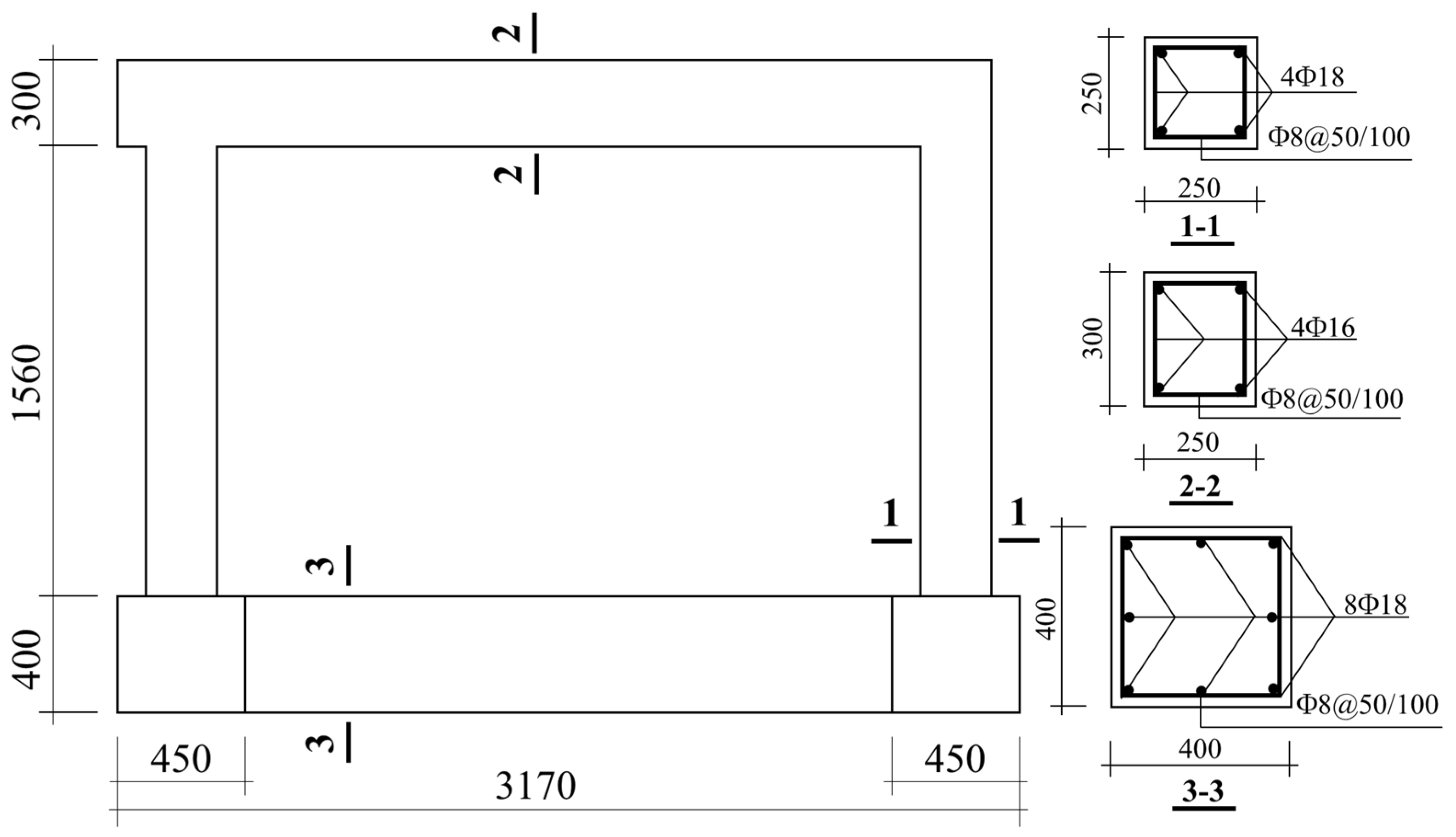


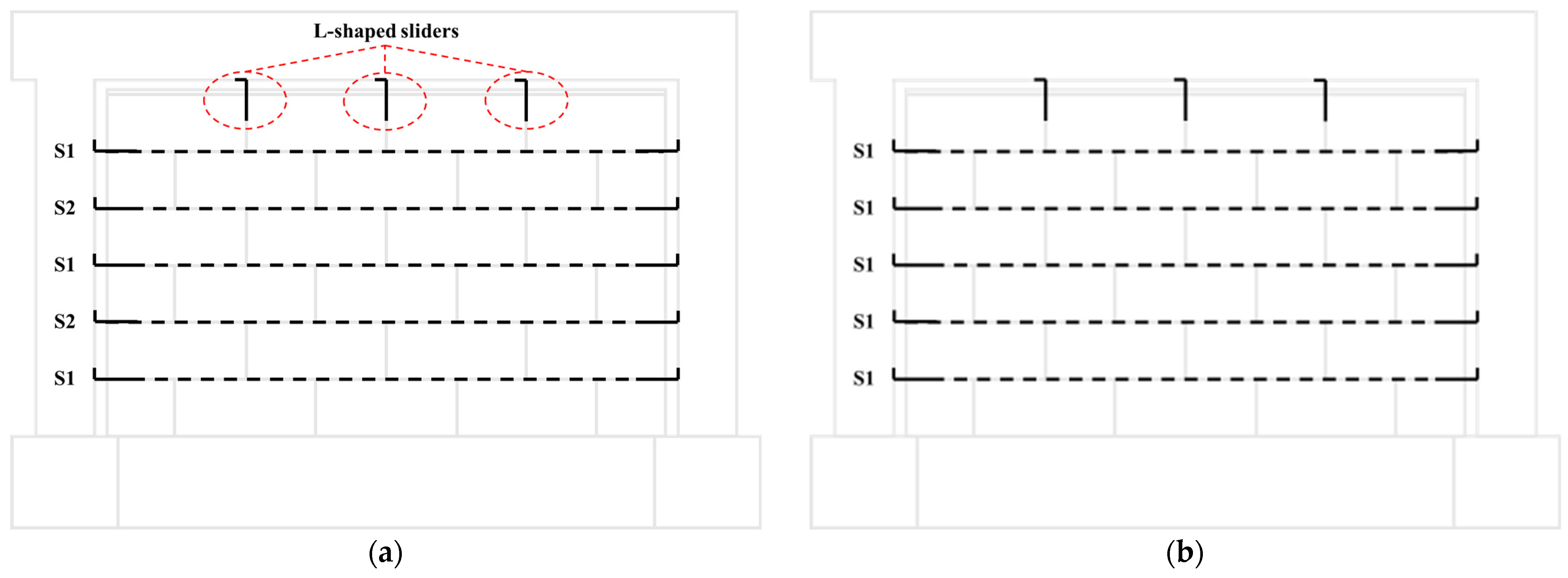

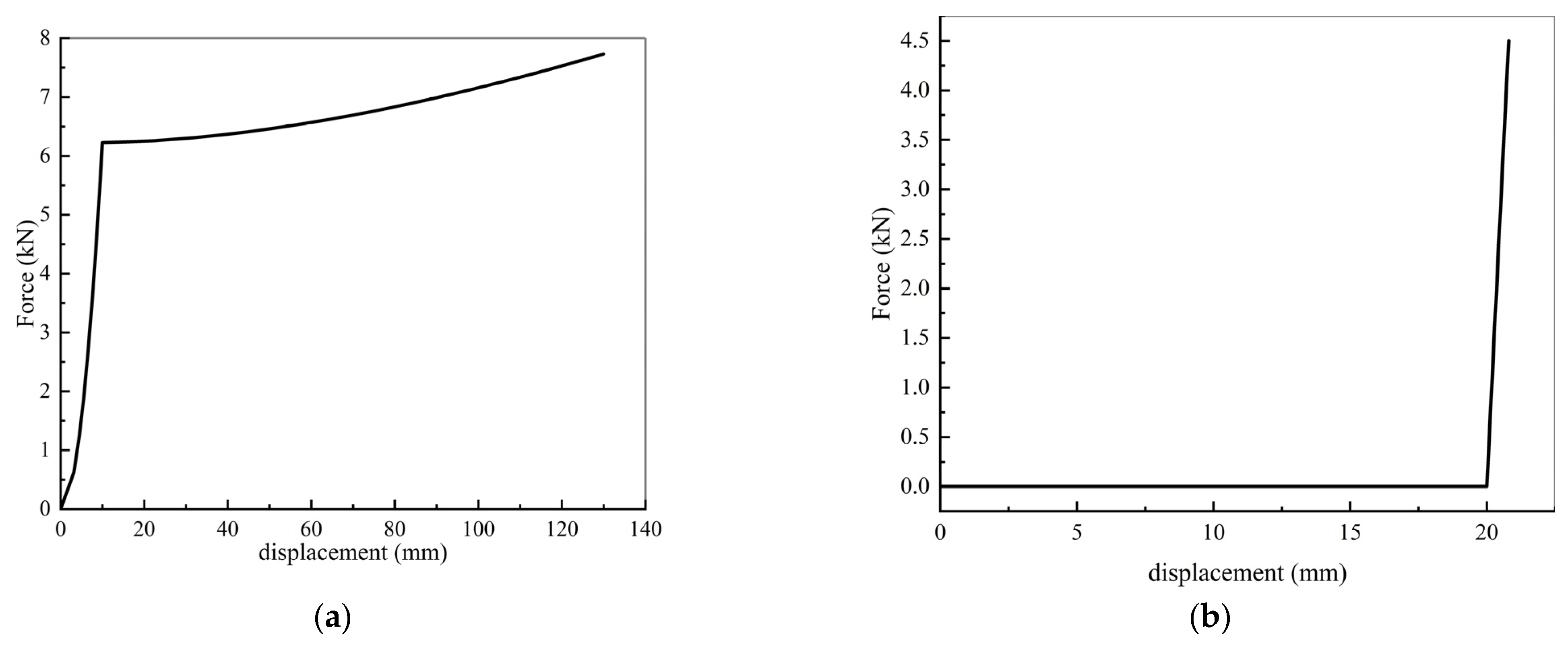


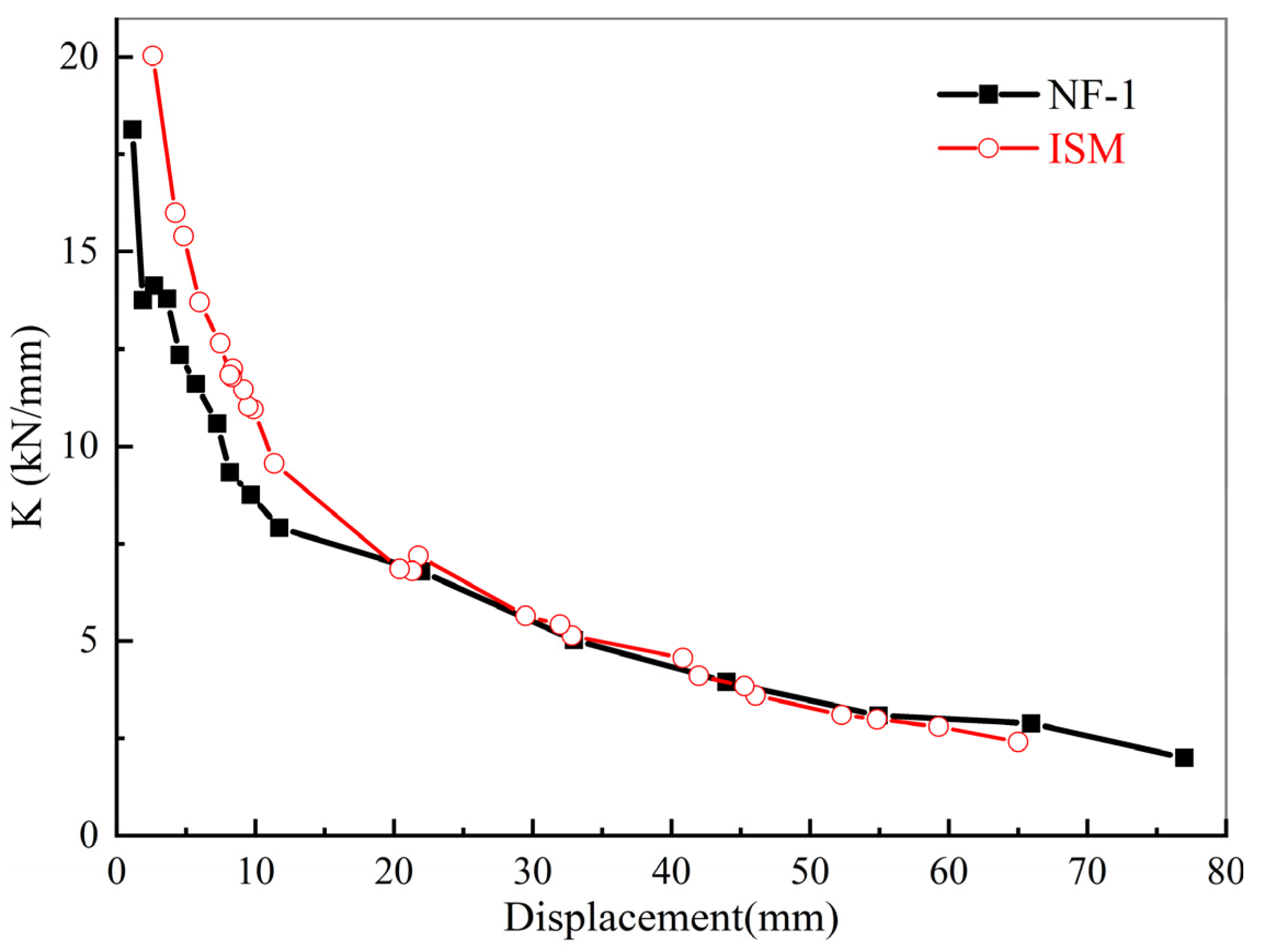

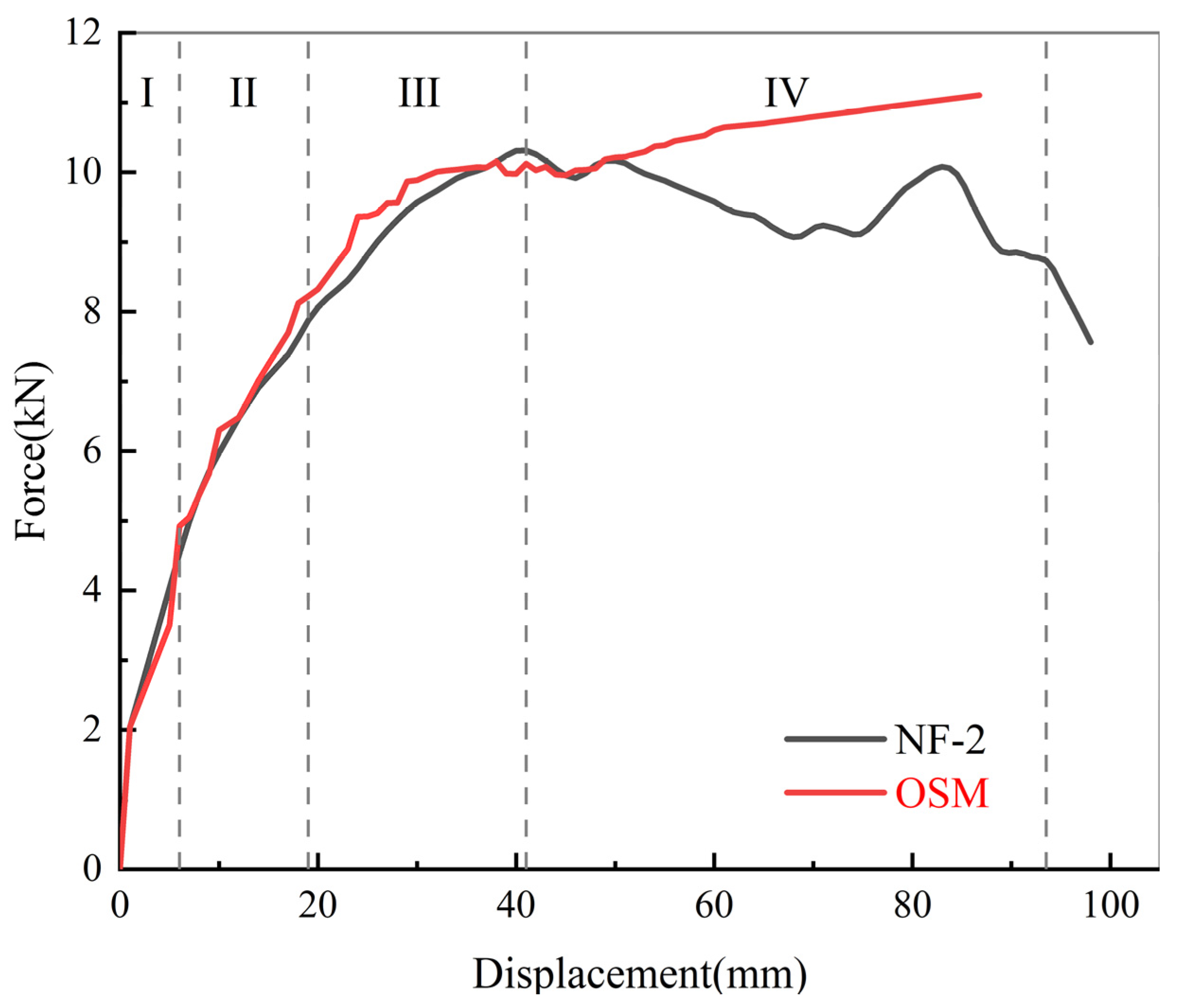

| Type | ES0 1 (MPa) | fy 2 (MPa) | α 3 | Ultimate Plastic Deformation Rate (%) | α1 4 |
|---|---|---|---|---|---|
| HRB400 | 2e5 | 400 | 0.001 | 50 | 0 |
| Position | fcc0 1 (MPa) | εcc0 2 | fccu 3 (MPa) | εccu 4 | dccu 5 | fcct 6 (MPa) | γSEC 7 | Sy 8 |
|---|---|---|---|---|---|---|---|---|
| Beam | 28.58 | 0.00528 | 24.29 | 0.0252 | 0.5 | 2.97 | 2280 | 0.00261 |
| Column | 29.2 | 0.00555 | 24.82 | 0.0264 | 0.5 | 3 | 2280 | 0.00263 |
| Dilation Angle (°) | Eccentricity | Yield Constant | Viscosity Coefficient | |
|---|---|---|---|---|
| 30 | 0.1 | 1.16 | 0.667 | 0.005 |
| Material | ES 1 (MPa) | fc 2 (MPa) | ft 3 (MPa) | ν 4 | ρ 5 (Kg/m3) |
|---|---|---|---|---|---|
| AAC masonry | 1856.33 | 2.90 | 0.657 | 0.36 | 602.3 |
| Pseudo-Linear Stage (I) | Strengthening—Yielding Stage (II–III) | Degradation Stage (IV) | |||||
|---|---|---|---|---|---|---|---|
| Cracking Point | Yielding Point 1 | Peak Point | Failure Point | ||||
| Load (kN) | Displacement 2 (mm) | Load (kN) | Displacement 2 (mm) | Load (kN) | Displacement 2 (mm) | Load (kN) | Displacement 2 (mm) |
| 4.5 | 6.00 | 7.87 | 19.00 | 10.31 | 41.00 | 8.73 | 93.50 |
Disclaimer/Publisher’s Note: The statements, opinions and data contained in all publications are solely those of the individual author(s) and contributor(s) and not of MDPI and/or the editor(s). MDPI and/or the editor(s) disclaim responsibility for any injury to people or property resulting from any ideas, methods, instructions or products referred to in the content. |
© 2024 by the authors. Licensee MDPI, Basel, Switzerland. This article is an open access article distributed under the terms and conditions of the Creative Commons Attribution (CC BY) license (https://creativecommons.org/licenses/by/4.0/).
Share and Cite
Wang, X.; Xiong, L.; Wang, Z. Simplified Model Study of Autoclaved Aerated Concrete Masonry Flexible Connection Infilled Frames with Basalt Fiber Grating Strips. Buildings 2024, 14, 1033. https://doi.org/10.3390/buildings14041033
Wang X, Xiong L, Wang Z. Simplified Model Study of Autoclaved Aerated Concrete Masonry Flexible Connection Infilled Frames with Basalt Fiber Grating Strips. Buildings. 2024; 14(4):1033. https://doi.org/10.3390/buildings14041033
Chicago/Turabian StyleWang, Xin, Lihong Xiong, and Zhuoxin Wang. 2024. "Simplified Model Study of Autoclaved Aerated Concrete Masonry Flexible Connection Infilled Frames with Basalt Fiber Grating Strips" Buildings 14, no. 4: 1033. https://doi.org/10.3390/buildings14041033
APA StyleWang, X., Xiong, L., & Wang, Z. (2024). Simplified Model Study of Autoclaved Aerated Concrete Masonry Flexible Connection Infilled Frames with Basalt Fiber Grating Strips. Buildings, 14(4), 1033. https://doi.org/10.3390/buildings14041033





